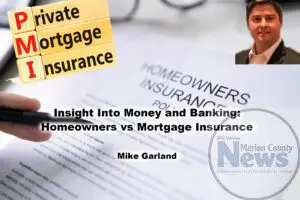Mike Garland
 I am often asked what the differences are between home insurance and private mortgage insurance. While both types of insurance coverage play an important role in home financing, home insurance policy and private mortgage insurance (PMI) offer two different types of insurance coverage. Home insurance provides the homeowner with protection for their home and contents against damage caused by unforeseen events. PMI, also called mortgage insurance, is an insurance policy that protects the lender, not the homeowner. Mortgage insurance will increase the monthly mortgage cost for the borrower and provide no benefit to the homeowner. Mortgage insurance provides protection to the mortgage lender if the homeowner is unable to make the mortgage payments and defaults on the mortgage result in foreclosure. A borrower can typically pay between thirty and seventy dollars in PMI each month for every $100,000 of loan principal balance.
I am often asked what the differences are between home insurance and private mortgage insurance. While both types of insurance coverage play an important role in home financing, home insurance policy and private mortgage insurance (PMI) offer two different types of insurance coverage. Home insurance provides the homeowner with protection for their home and contents against damage caused by unforeseen events. PMI, also called mortgage insurance, is an insurance policy that protects the lender, not the homeowner. Mortgage insurance will increase the monthly mortgage cost for the borrower and provide no benefit to the homeowner. Mortgage insurance provides protection to the mortgage lender if the homeowner is unable to make the mortgage payments and defaults on the mortgage result in foreclosure. A borrower can typically pay between thirty and seventy dollars in PMI each month for every $100,000 of loan principal balance.
Conventional mortgage financing means the mortgage meets the requirements of Fannie Mae or Freddie Mac. Both Fannie Mae and Freddie Mac are government-sponsored companies that buy mortgages from lenders and sell mortgages to investors. For conventional mortgage financing, mortgage insurance will be required by the lender if the loan-to-value (LTV) ratio of the mortgage is greater than eighty percent of the purchase price. An LTV ratio is a measure comparing the amount of the mortgage to the appraised value of the property and is expressed as a percentage. The lower the down payment, the higher the LTV ratio of the mortgage loan. As a borrower makes their monthly mortgage payments, this gradually increases their equity in the property and reduces the LTV over time.
The Homeowners Protection Act of 1998 outlines the requirements for the removal of mortgage insurance by the lender. For conventional mortgage financing, the lender must automatically remove the mortgage insurance when your mortgage balance reaches an LTV ratio of seventy-eight percent of the original purchase price. This is on the condition that the borrower is current on mortgage payments with the lender and that the borrower has not missed any mortgage payments. The borrower can request that the mortgage insurance be removed by the lender once the loan-to-value ratio reaches eighty percent, but this request for the mortgage insurance to be removed by the lender is not guaranteed because it would be seventy-eight percent LTV.
For Federal Housing Administration (FHA) mortgage financing, the borrower must pay a mortgage insurance premium (MIP) instead of PMI. MIP is similar to private mortgage insurance and provides the lender with the same protections if you are unable to repay your loan. For an FHA mortgage, if the LTV is greater than 90%, the borrower must pay the MIP for the term of the loan. If the LTV is ninety percent or less, the borrower would pay the MIP for 11 years before the MIP is removed.
To avoid paying PMI, a prospective owner would prepare for a down payment of at least twenty percent. This larger down payment would avoid the additional monthly fees associated with mortgage default insurance. If a current homeowner has conventional mortgage financing and wishes to remove the PMI associated with their current mortgage, lenders will often allow the borrower to make additional payments on top of the scheduled monthly mortgage payments. The additional amount paid could be applied to the outstanding principal balance of the mortgage. This is called a principal reduction.
Paying a little extra for your mortgage each month can go a long way. This is not only useful for removing mortgage insurance, but also for paying off your mortgage sooner than expected. Not all lenders accept principal reductions, and a borrower would want to discuss options with their mortgage lender to ensure that a principal reduction is available. A capital reduction requires dedication and discipline for long-term benefits and would be a technique to accelerate the removal of mortgage insurance.
Mike Garland is an Accredited Mortgage Professional® (AMP) with the Mortgage Bankers Association. I also graduated with honors from the School of Consumer Credit, affiliated with the Tennessee Mortgage Bankers Association, and work as a senior account manager for JMAC Lending.